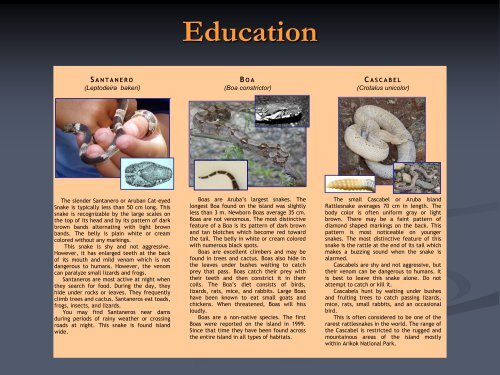Boa Constrictors on the Aruba - WildAruba
Boa Constrictors on the Aruba - WildAruba
Boa Constrictors on the Aruba - WildAruba
Create successful ePaper yourself
Turn your PDF publications into a flip-book with our unique Google optimized e-Paper software.
S A N T A N E R O<br />
(Leptodeira bakeri)<br />
The slender Santanero or <strong>Aruba</strong>n Cat-eyed<br />
Snake is typically less than 50 cm l<strong>on</strong>g. This<br />
snake is recognizable by <strong>the</strong> large scales <strong>on</strong><br />
<strong>the</strong> top of its head and by its pattern of dark<br />
brown bands alternating with light brown<br />
bands. The belly is plain white or cream<br />
colored without any markings.<br />
This snake is shy and not aggressive.<br />
However, it has enlarged teeth at <strong>the</strong> back<br />
of its mouth and mild venom which is not<br />
dangerous to humans. However, <strong>the</strong> venom<br />
can paralyze small lizards and frogs.<br />
Santaneros are most active at night when<br />
<strong>the</strong>y search for food. During <strong>the</strong> day, <strong>the</strong>y<br />
hide under rocks or leaves. They frequently<br />
climb trees and cactus. Santaneros eat toads,<br />
frogs, insects, and lizards.<br />
You may find Santaneros near dams<br />
during periods of rainy wea<strong>the</strong>r or crossing<br />
roads at night. This snake is found island<br />
wide.<br />
Educati<strong>on</strong><br />
B OA<br />
(<str<strong>on</strong>g>Boa</str<strong>on</strong>g> c<strong>on</strong>strictor)<br />
<str<strong>on</strong>g>Boa</str<strong>on</strong>g>s are <strong>Aruba</strong>’s largest snakes. The<br />
l<strong>on</strong>gest <str<strong>on</strong>g>Boa</str<strong>on</strong>g> found <strong>on</strong> <strong>the</strong> island was slightly<br />
less than 3 m. Newborn <str<strong>on</strong>g>Boa</str<strong>on</strong>g>s average 35 cm.<br />
<str<strong>on</strong>g>Boa</str<strong>on</strong>g>s are not venomous. The most distinctive<br />
feature of a <str<strong>on</strong>g>Boa</str<strong>on</strong>g> is its pattern of dark brown<br />
and tan blotches which become red toward<br />
<strong>the</strong> tail. The belly in white or cream colored<br />
with numerous black spots.<br />
<str<strong>on</strong>g>Boa</str<strong>on</strong>g>s are excellent climbers and may be<br />
found in trees and cactus. <str<strong>on</strong>g>Boa</str<strong>on</strong>g>s also hide in<br />
<strong>the</strong> leaves under bushes waiting to catch<br />
prey that pass. <str<strong>on</strong>g>Boa</str<strong>on</strong>g>s catch <strong>the</strong>ir prey with<br />
<strong>the</strong>ir teeth and <strong>the</strong>n c<strong>on</strong>strict it in <strong>the</strong>ir<br />
coils. The <str<strong>on</strong>g>Boa</str<strong>on</strong>g>’s diet c<strong>on</strong>sists of birds,<br />
lizards, rats, mice, and rabbits. Large <str<strong>on</strong>g>Boa</str<strong>on</strong>g>s<br />
have been known to eat small goats and<br />
chickens. When threatened, <str<strong>on</strong>g>Boa</str<strong>on</strong>g>s will hiss<br />
loudly.<br />
<str<strong>on</strong>g>Boa</str<strong>on</strong>g>s are a n<strong>on</strong>-native species. The first<br />
<str<strong>on</strong>g>Boa</str<strong>on</strong>g>s were reported <strong>on</strong> <strong>the</strong> island in 1999.<br />
Since that time <strong>the</strong>y have been found across<br />
<strong>the</strong> entire island in all types of habitats.<br />
C A S C A B E L<br />
(Crotalus unicolor)<br />
The small Cascabel or <strong>Aruba</strong> Island<br />
Rattlesnake averages 70 cm in length. The<br />
body color is often uniform gray or light<br />
brown. There may be a faint pattern of<br />
diam<strong>on</strong>d shaped markings <strong>on</strong> <strong>the</strong> back. This<br />
pattern is most noticeable <strong>on</strong> younger<br />
snakes. The most distinctive feature of this<br />
snake is <strong>the</strong> rattle at <strong>the</strong> end of its tail which<br />
makes a buzzing sound when <strong>the</strong> snake is<br />
alarmed.<br />
Cascabels are shy and not aggressive, but<br />
<strong>the</strong>ir venom can be dangerous to humans. It<br />
is best to leave this snake al<strong>on</strong>e. Do not<br />
attempt to catch or kill it.<br />
Cascabels hunt by waiting under bushes<br />
and fruiting trees to catch passing lizards,<br />
mice, rats, small rabbits, and an occasi<strong>on</strong>al<br />
bird.<br />
This is often c<strong>on</strong>sidered to be <strong>on</strong>e of <strong>the</strong><br />
rarest rattlesnakes in <strong>the</strong> world. The range of<br />
<strong>the</strong> Cascabel is restricted to <strong>the</strong> rugged and<br />
mountainous areas of <strong>the</strong> island mostly<br />
within Arikok Nati<strong>on</strong>al Park.


